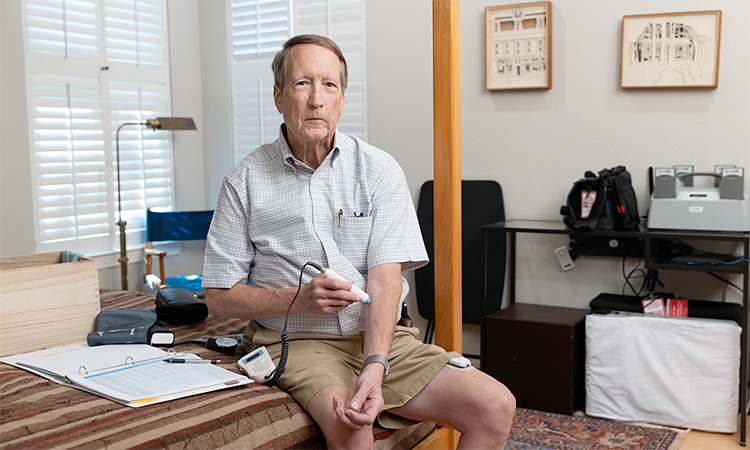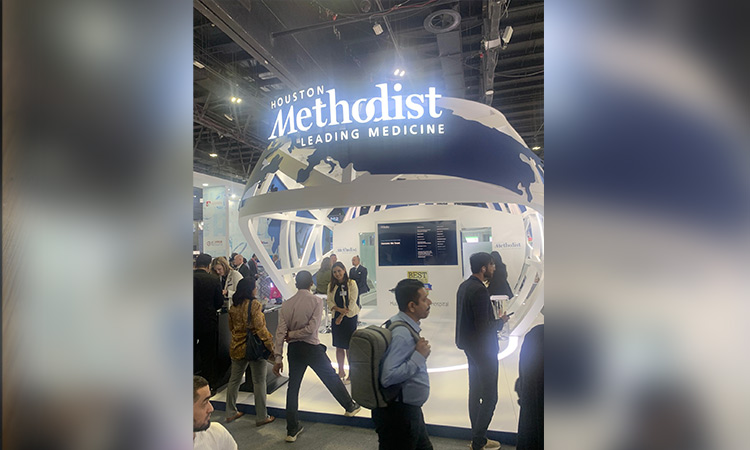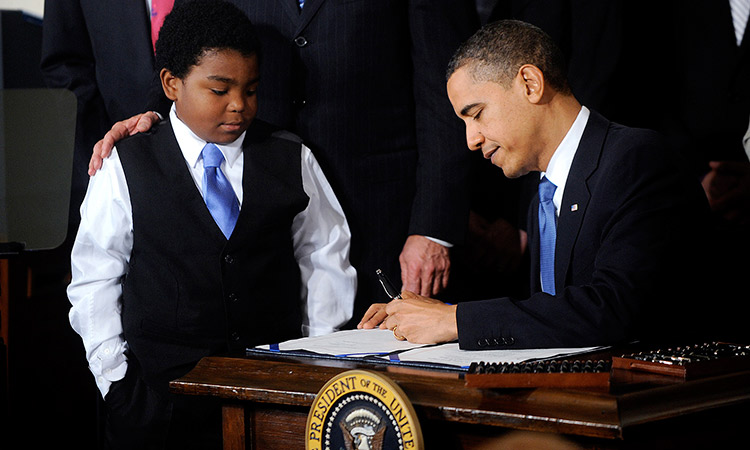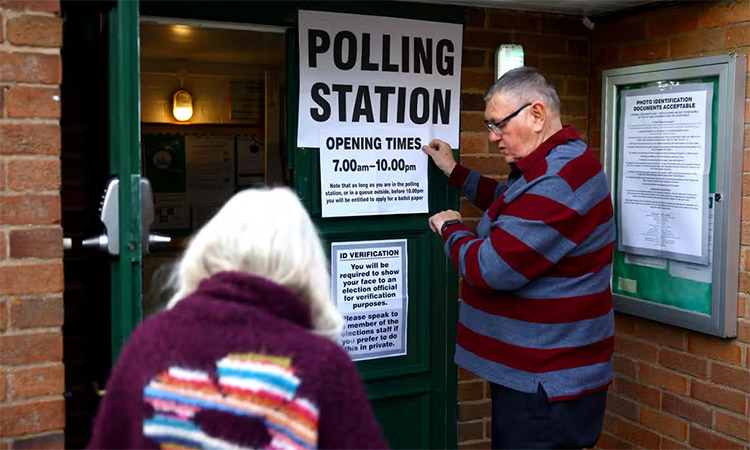Patients facing death opt for life-saving devices

Sid Covington, of Austin, Texas, had a mechanical pump implanted in his heart in January 2022 due to advanced heart failure. Tribune News Service
Daniel Chang, Holly K. Hacker, Tribune News Service
Too old and too sick for a heart transplant, Arvid Herrman was given a choice: have a mechanical pump implanted in his heart, potentially keeping him alive for several years, or do nothing and almost certainly die within a year. The 68-year-old Wisconsin farmer chose the pump, called a HeartMate 3 — currently the only FDA-approved device of its kind in use. Instead of extending his life, though, the device led to his death, according to a lawsuit filed in December 2020 by his daughter Jamie Edwards.
The lawsuit alleged that Herrman died because a defect in the locking mechanism of the HeartMate 3 prevented the device from sealing, causing multiple strokes and leading to a severe brain injury and multiorgan failure. Herrman “could not have anticipated the danger this defect … created for him,” the lawsuit said.
Herrman’s death was reported to a Food and Drug Administration database where the public can learn about device-related deaths, serious injuries, and malfunctions. The event was also described in the peer-reviewed Journal of Heart and Lung Transplantation. In September 2021, Ramon Flores Sr. had the same device implanted at Methodist Hospital of San Antonio. A lawsuit his family filed in August alleges that the locking mechanism defect led to air embolism strokes. Flores died eight days after surgery, at age 76.
“How many other people is this going to happen to?” said his daughter, Alanna Flores Blanco, 52. “We never, ever were explained that the device could malfunction and this could happen.” After the deaths of Herrman and Flores, Thoratec Corp., the device’s manufacturer, evaluated the pumps involved. In both cases, Thoratec, a subsidiary of Abbott Laboratories, confirmed a bent locking arm. But “a direct correlation” between the HeartMate 3 and the deaths “could not conclusively be established,” the manufacturer reported to the FDA. Abbott did not respond to questions about the deaths or the alleged defects. The manufacturer denied liability in both cases. It settled Herrman’s lawsuit this fall, and the Flores case is ongoing.
The men’s deaths are among more than 4,500 reports since August 2017 in which the HeartMate 3 may have caused or contributed to a patient’s death, according to a KFF Health News analysis of the FDA’s database of medical device incidents, known as the Manufacturer and User Facility Device Experience, or MAUDE. Hospitals, doctors, and others report device-related deaths, serious injuries, and malfunctions to manufacturers, who are required to investigate and report cases to the FDA. In nearly 90% of those 4,500-plus reports, Thoratec said it found no problem with the device or how it was used, according to a KFF Health News review of the FDA database. In cases where Abbott finds the HeartMate 3 did not cause or contribute to a death or serious injury, the company files “corrective reports,” said Justin Paquette, an Abbott public affairs director. He added, “The complexity of the device – combined with patients battling late stage heart failure and associated comorbidities – creates very dynamic clinical care situations.”
Abbott said the HeartMate 3 is the safest iteration yet of any left ventricular assist device, or LVAD, a type of mechanical heart pump introduced in the 1960s and refined over the last six decades. The HeartMate 3 was first approved by the FDA, for use in patients awaiting a heart transplant, in August 2017, and one year later it was approved as a long-term therapy. The device is often considered only for patients with end-stage heart failure, and even then it is a last resort. HeartMate 3 has “dramatically improved the safety of LVADs by reducing rates of complications that had historically challenged heart pump technology, including clotting, stroke and bleeding,” Paquette said. As recently as August, the FDA also expressed support for the device. “The FDA believes the benefits of HeartMate 3 continue to outweigh the risks for this vulnerable patient population with few available alternatives,” said Jeremy Kahn, an agency spokesperson.
Others aren’t so sure. Former FDA medical device official Madris Kinard sees the high number of death reports as a warning. “To me this is a safety signal and it’s hard to know if the FDA is working on something to address it,” said Kinard, founder of Device Events, a company that makes FDA device data more user-friendly for hospitals, law firms, investors, and others. “You have to wonder why (death reports are) still happening, and at the same rate.” Larry Kessler, a former director in the FDA’s medical device office, agrees the death reports for HeartMate 3 need more study. “The FDA may be missing some signals,” he said. Perhaps “there’s a little more here than meets the eye.” Not all device problems are reported to MAUDE, and submitting a report is not necessarily an admission that a device caused a death or a serious injury. Device problem reports can be inaccurate or incomplete, or lack verification, and a single incident may be reported more than once — or not at all.
Those limitations ultimately can leave patients and their caregivers uninformed about risks associated with a device such as the HeartMate 3, said Sanket Dhruva, a cardiologist and expert in medical device safety and regulation at the University of California-San Francisco. “They’re making perhaps the biggest decision of their lives: Do I proceed with an LVAD or not? And even if I proceed, what are the risks I’m facing?” he said. “And they are left with incomplete data and uncertainty about how to make that determination.” Even doctors cannot use the FDA database as a tool to effectively counsel patients, Dhruva added.
“lf you don’t know what is a real safety signal and what’s not,” he said, “then how can that information help us to calibrate our benefits-and-risks discussion with patients?”
The HeartMate 3 is not the only device whose safety profile is hard to ascertain in MAUDE, Dhruva said. The information in the FDA database is insufficient to give patients an adequate understanding of any medical device’s safety risks and reflects “the overall weakness of postmarket surveillance” after a device has been approved for sale, he said. Under federal regulations, device manufacturers typically must report adverse events to the FDA within 30 days of learning about them, and that data is often used by researchers and regulators to identify potential safety concerns. Reports also can be submitted voluntarily by doctors, patients, or others. The FDA says that reports don’t need to be filed if the manufacturer determines that a device did not cause or contribute to an adverse event. But with millions of reports for thousands of devices, it can be difficult to detect and prevent problems that put patients at risk.







